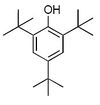Difference between revisions of "2,4,6-tri-tert-butylphenol"
Dronkers J (talk | contribs) |
|||
| (10 intermediate revisions by 2 users not shown) | |||
| Line 1: | Line 1: | ||
| − | + | {{Tocright | |
| + | }} | ||
{{Definition|title=2,4,6-tri-''tert''-butylphenol | {{Definition|title=2,4,6-tri-''tert''-butylphenol | ||
| − | |definition=2,4,6-tri-''tert''-butylphenol has been confused with an other chemical called dodecylphenol which has the same molecular formula but a different structure | + | |definition=2,4,6-tri-''tert''-butylphenol is a chemical which has been confused with an other chemical called dodecylphenol which has the same molecular formula but a different structure<ref name=O>[https://www.ospar.org/documents?v=6977 OSPAR background document on 2,4,6-tri-''tert''-butylphenol]</ref>. }} |
| − | <ref name = | ||
| − | |||
== Notes == | == Notes == | ||
| Line 19: | Line 18: | ||
|} | |} | ||
| − | Less than 50 tonnes of 2,4,6-tri-''tert''-butylphenol | + | Less than 50 tonnes of 2,4,6-tri-''tert''-butylphenol are used in the EU each year. It can be used as an intermediate in the production of antioxidants, in rubber or plastic and as an lubricating agent in the transport sector. As an intermediate it shouldn't enter the environment unless by discharges<ref name=O/>. |
| − | It is a chemical with a low volatility, making it | + | It is a chemical with a low [[volatile|volatility]], making it unlikely that it enters the atmosphere, where it would be degraded rapidly. It has a low water solubility (0,521 mg/l) and a strong tendency to [[adsorption|adsorb]] to soils and sediments. Both in water and sediments, it isn't readily (bio)degraded and considered [[persistent]]. |
| − | It has a low water solubility (0,521 mg/l) and a strong tendency to adsorb to soils and sediments, | + | It has a high tendency to [[bioaccumulation|bioaccumulate]] and is likely to [[biomagnification|biomagnify]] through [[food chain|food chains]]. |
| − | It has a high tendency to bioaccumulate and is likely to [[biomagnification|biomagnify]] | + | |
| − | In fresh water is has been shown to be toxic for fish and for algae at concentrations above 0,061 mg/l and 0,033 mg/l respectively. | + | In fresh water is has been shown to be acutely [[toxic]] for fish and for algae at concentrations above 0,061 mg/l and 0,033 mg/l respectively. |
| − | There is currently | + | There is currently little information available on the levels of 2,4,6-tri-''tert''-butylphenol in the marine environment. It has been estimated (by modelling the emissions) that concentrations might reach 0,32 µg/l<ref name=O/>. |
<P> | <P> | ||
<BR> | <BR> | ||
| Line 39: | Line 38: | ||
== See also == | == See also == | ||
| − | [ | + | [https://pubchem.ncbi.nlm.nih.gov/compound/2_4_6-Tri-tert-butylphenol pubchem 2,4,6-tri-''tert''-butylphenol] |
<P> | <P> | ||
<BR> | <BR> | ||
<P> | <P> | ||
| + | {{author | ||
| + | |AuthorID=19826 | ||
| + | |AuthorFullName=Daphnis De Pooter | ||
| + | |AuthorName=Daphnisd}} | ||
==References== | ==References== | ||
<references/> | <references/> | ||
| − | [[Category: | + | [[Category:Toxicity chemicals]] |
Latest revision as of 12:58, 9 August 2020
Definition of 2,4,6-tri-tert-butylphenol:
2,4,6-tri-tert-butylphenol is a chemical which has been confused with an other chemical called dodecylphenol which has the same molecular formula but a different structure[1].
This is the common definition for 2,4,6-tri-tert-butylphenol, other definitions can be discussed in the article
|
Notes
| 2,4,6-tri-tert-butylphenol |
|---|

|
| Formula |
| C18H300 |
Less than 50 tonnes of 2,4,6-tri-tert-butylphenol are used in the EU each year. It can be used as an intermediate in the production of antioxidants, in rubber or plastic and as an lubricating agent in the transport sector. As an intermediate it shouldn't enter the environment unless by discharges[1].
It is a chemical with a low volatility, making it unlikely that it enters the atmosphere, where it would be degraded rapidly. It has a low water solubility (0,521 mg/l) and a strong tendency to adsorb to soils and sediments. Both in water and sediments, it isn't readily (bio)degraded and considered persistent. It has a high tendency to bioaccumulate and is likely to biomagnify through food chains.
In fresh water is has been shown to be acutely toxic for fish and for algae at concentrations above 0,061 mg/l and 0,033 mg/l respectively. There is currently little information available on the levels of 2,4,6-tri-tert-butylphenol in the marine environment. It has been estimated (by modelling the emissions) that concentrations might reach 0,32 µg/l[1].
Environmental standards and legislation
Included in the OSPAR list of substances of priority action
See also
pubchem 2,4,6-tri-tert-butylphenol
Please note that others may also have edited the contents of this article.
|